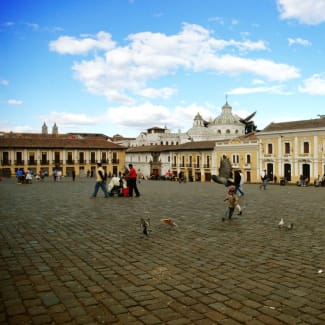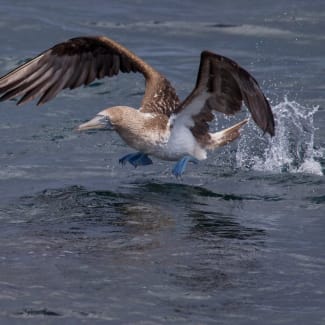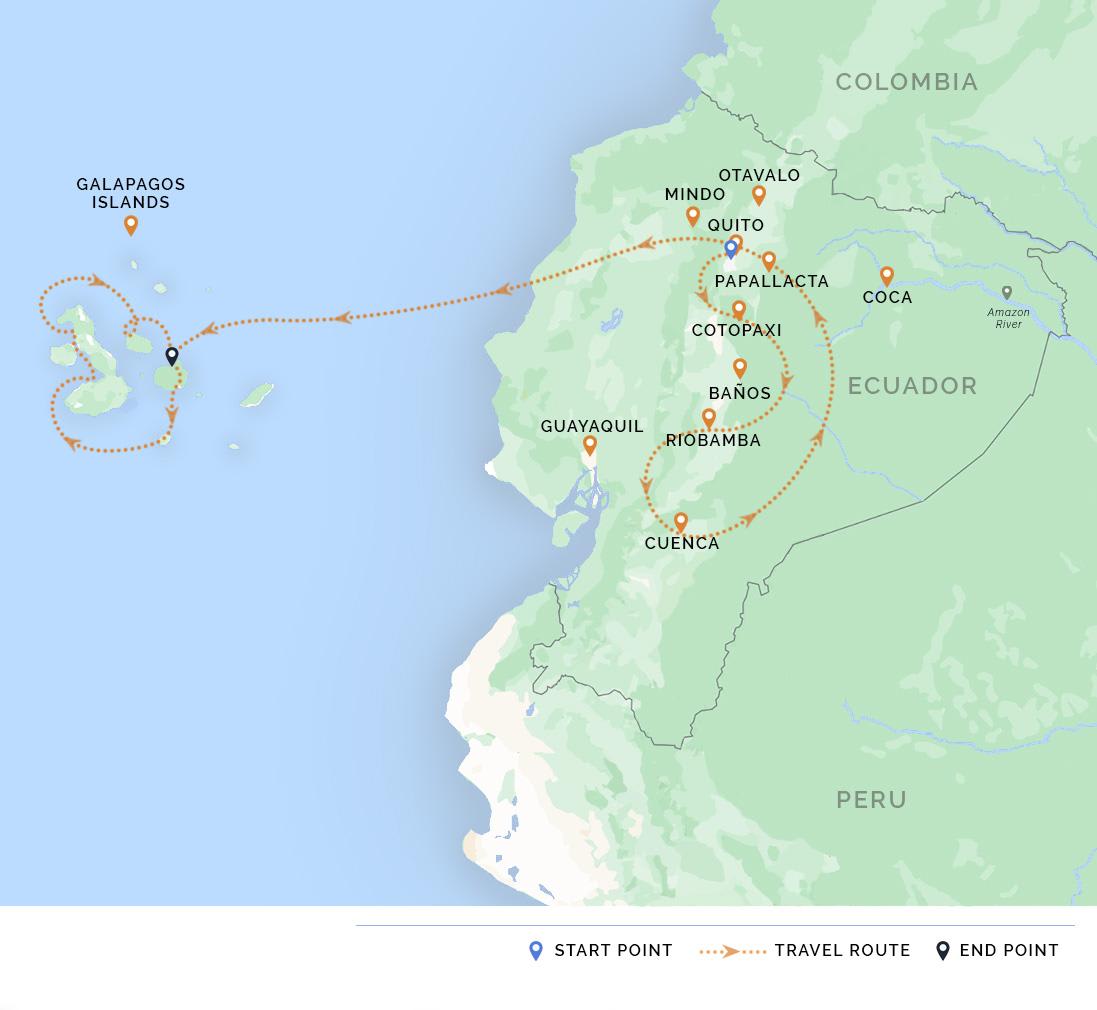
-
Adventure
Overview
For those who want to see and experience more of Ecuador, this 16-day Avenue of the Volcanoes & Galápagos tour is the perfect opportunity. Explore volcanoes, immerse yourself in the arts and crafts of the Andes, discover archaeological and historic sites, and experience the unique nature and beauty of the Galápagos Islands on a spectacular cruise.
Avenue of the Volcanoes Tour
Your tour begins in the populous capital city of Quito. Here you will explore the famous colonial center, indulge in a unique chocolate excursion, and visit the equatorial line just to the north. Then it’s on to the most famous and prominent volcano in Ecuador.
Once you arrive at Cotopaxi National Park, you’ll explore and learn about this incredible geological feature, which is part of the complex of volcanoes on the Ring of Fire. Visit the surrounding small towns and authentic, indigenous markets before approaching the next volcano crater, Quilotoa, and its mysterious natural green lake.
As the tour continues, you’ll discover majestic Andean landscapes filled with native llamas and alpacas and explore mysterious archaeological sites. You’ll also enjoy stops in local art galleries full of Andean folklore influences.
The Andes people are known for their many crafts and handiworks, such as textiles and leatherwear, so you’ll discover these first-hand along the Craftman’s Trail. Visit workshops, including ones specializing in musical instruments or traditional jewelry-making as well.
The next destination is Cuenca, one of the most beautiful cities in all of Ecuador. Enjoy a day exploring this city and learning its history before heading back to Quito.
Galápagos Islands Adventure
After the incredible mainland tour of Ecuador, it’s time to move on to the islands of Galápagos for a nature and wildlife extravaganza! A quick flight from Quito to Baltra brings you to the islands for incredible experiences starting immediately. After spending the day exploring, you’ll board the Mary Anne, your floating accommodations for the next seven nights.
The Mary Anne is a 216-foot sailing vessel, complete with tall sails and a deep draft. Climb aboard and feel like you’re back in the days of pirates and the great explorers. Settle into your choice of either a Single or Double Cabin, each with its own hot water bathroom and air-conditioning for added comfort. Then roam the ship and stretch out on the sun deck, relax in the lounge, or settle in to read for a spell in the library. You’ll enjoy the best of modern cuisine in the dining area, including fresh, local seafood dishes prepared by the Ecuadorian chef on board.
Your cruise will sail through the enchanted islands, stopping to visit several of them, including Floreana, Isabela, Fernandina, Santiago, and North Seymour. Each one offers something unique to experience, so you won’t want to miss any of them.
See giant tortoises and learn about their journey. Explore pirate hideouts, and look for flamingos, sea lions, penguins, and red-footed boobies. Hike inland to see land iguanas or stroll along pristine beaches of white or volcanic dark sand. The waters surrounding Galápagos are the second largest marine reserve in the world, so stay on the lookout for whales, dolphins, colorful fish, and maybe even a shark or two.
The fun continues with thrilling panga rides, snorkeling various sites, and exploring volcanic landscapes, including craters and lava tunnels. On the last morning of your cruise, you’ll visit the home of a large sea lion colony before disembarking and flying back to the mainland with a memory full to the brim with moments to treasure for a lifetime.
Itinerary & Prices
All itineraries are subject to change due to seasonal weather conditions (and resultant variations in river and tributary water levels) affecting accessibility to locations. Thus navigation routes, times and excursions may need to be modified at the cruise captain’s or your guide's discretion.
Arrival in Quito!
You arrive in the historical city of Quito and are transferred to your hotel in the comfort of our private, air-conditioned vehicle. Quito is the most populous city in Ecuador, and the second-highest capital city in the world. Founded in 1534 by Spanish Conquistadors, it is nestled in the lower Andes mountain range, creating quite a dramatic backdrop to the colonial architecture of the center and the more modern suburbs, which sit in the rocks of the mountains themselves. Quito is located a short drive south of the equator – Ecuador is, in fact, the Spanish word for the equator, the city sits on the eastern slope of the Pichincha volcano.
Quito lies in the valley of the Guayllabamba River, flanked by volcanoes, many of which are snow-capped, and visible from the city on a clear day. Quito’s altitude is listed at 2,820 meters (9,250 feet). The colonial influence is strong in the traditional center of the city and any visit to Quito should include a stroll around this area, which was one of the world’s first UNESCO World Heritage Sites. Buildings of particular interest being the Carondelet Palace, the Cathedral, the four main churches, and the Basilica del Voto Nacional. The center of Quito is the most untouched and also the biggest colonial center of any city in the Americas.
Meals (x)

City Tour & The Equatorial Line
A trip to Ecuador encapsulates a mix of history, fascinating indigenous cultures, slow winding rivers, and lush tropical forests, spectacular snowcapped volcanoes, and some of the most exciting wildlife on earth.
Our starting place today is the ‘Mitad del Mundo’, a site located just 45 minutes north of Quito, where a monument marks the equator at its closest point to the city. Archaeological evidence shows that both pre-Inca and Inca civilizations recognized and celebrated the equinox, the day the sun is directly over the equator. We make the 45-minute journey northwest to the equatorial line, where we will walk the rim of the extinct Pululahua volcanic crater. From there we visit the “Ciudad Mitad del Mundo” a group of buildings designed to explain the significance of the site, as well as the Ethnographic Initñam Museum, located right on the Equator. Here you will have the chance to plant your feet in two hemispheres at the same time!
Back in Quito, after lunch we will visit the city’s impressive colonial center, the reason Quito was the first city to be named a world heritage site. First on the agenda is a walk through the main plaza, the ‘plaza de la Independencia’, where you will see the Government Palace, the Cathedral, and some of the most important churches built around the XVI and XVII centuries, including the San Francisco Monastery, the first building built in the whole city. We wind down from a busy day’s sightseeing with an excursion all about chocolate! Ecuador’s unique equatorial climate provides the perfect environment for growing the world’s finest cocoa – Cacao Arriba. Cocoa has been revered in Latin America for over 5,000 years and Spanish explorers loved it so much they called it the ‘Food of the Gods’. Our chocolate experience starts with a guide explaining the history of cocoa in Ecuador, followed by a chocolate tasting.
Meals (B, L)

Cotopaxi National Park
Cotopaxi is the most prominent and famous volcano in Ecuador and its almost symmetrical cone visible on the skyline from Quito. Rising to a height of over 12 thousand feet the volcano is part of a complex of volcanoes on the Ring of Fire and is home to one of the few equatorial glaciers in the world.
At the foot of the volcano is the entrance to the Cotopaxi National Park where we make a stop at the visitor center to learn about the exciting history of the Cotopaxi, past eruptions, and the impact those eruptions have had on the surrounding area, culture, and agriculture. The mountain’s colorful past also has had an impact geographically and this has, in turn, affected the wildlife. Our guide will explain how the volcano is central to life in the area and talk you through the unique characteristics of the local flora and fauna.
From there we visit Lake Limpiopungo which offers a chance for some spectacular sights. We take a walk around a part of the lake till we reach the perfect point to see the whole of Cotopaxi reflected in the lake as a mirror image. Quite often the low lying clouds can offer an additional dimension to this view and many a fantastic photograph has been taken from this viewpoint. If you feel like a longer walk, a 2-hour hike will take us to Mt. Cotopaxi’s J. Ribas refuge (4,800 m) where you will be able to enjoy spectacular views of the volcano and the surrounding Andean peaks.
Meals (B, L)

Indigenous Markets and Quilotoa Lake
Today we will visit Indian markets in the towns of either Saquisili, Pujili, Zumbahua, or Latacunga. These markets are almost completely untouched by outside influences and maintain their authenticity. Acting as the hub of the local society, as they have done for centuries, indigenous markers form the cornerstone of the social, economic, and cultural worlds of the Andes. From there, we visit the Quilotoa volcano crater, famous for the natural green lake that sits mysteriously in the crater. Here we have the option of a short walk – about 1.7 km – along the crater’s rim.
On the way back, we will stop to visit the art galleries in the community of Tigua, where we will be able to appreciate the paintings representative of the folklore of this special part of the Andes. The brightly colored unique style of the region’s painters, currently the third generation, has transcended local boundaries and is now internationally renowned. These days there are a lot of painters in Tigua, but Julio Toaquiza was the first and is still number one. We will visit Julio in his studio, and you will be able to see why his work is appreciated by museums and collectors worldwide for the bright colors, the meticulous detail, and the stories his paintings tell of life high up in the Andes
Meals (B, L, D)

Chimborazo, land of Llamas
No picture of the Andes is complete without the graceful figures of the native llamas, alpacas, guanacos, and vicuñas. These creatures, highly adapted to arid high altitudes, are both charismatic and graceful. From Riobamba, we enjoy majestic Andean landscapes as we make our way through the region.
Our destination is the local community of Palacio Real, which is dedicated to preserving the habitats in which the aforementioned creatures thrive. Here we will learn more about these curious camelids, and the various ways in which we can help ensure their survival.
Meals (B, L, D)

Ruins of Ingapirca
Today we transfer from Riobamba towards Cuenca, and en route have a few interesting sites to visit.
Ingapirca Fortress:
home to what is arguably the most famous archeological site in Ecuador, Ingapirca. Thought to be an observatory and fortress, this location is where the emperor and his entourage would rest during trips to the northern segment of the empire. The site was constructed from perfectly carved stone, joined seamlessly without the use or mortar.
The Devils Nose:
The biggest complication faced by the construction of the Trans-Andean railroad was the Devil’s Nose, a mountain with almost perpendicular walls. To overcome this obstacle, a zigzag railroad was built that climbs more than 500 meters in less than 12 km with steep ascents and descents. It today remains an impressive piece of engineering. From the Pistishi viewpoint, we will have a spectacular view of this feat, and the surrounding countryside.
Meals (B, L)

The Craftsman's Trail
One of the most interesting things in South America, and particularly in the Andean region is the abundance of fantastic local craftsmen. Many regions have whole styles of textiles and leatherwear unique to their culture and Ecuador truly is a country of artisans. Two such places are the towns of Gualaceo and Chordeleg, and these near neighbors are located just 45 minutes east of Cuenca. In these traditional settlements set in beautiful Andean landscapes, we will meet families who are still making textiles the way the “Cañaris” (the pre-Inca inhabitants) did more than 500 years ago.
Among the other workshops, we visit are a traditional jewelry workshop, a musical instrument workshop where regional variations on the guitar are a specialty. Guitars are a specialty of this area, so much so that the area is known as the ‘Guitar Trail’. We also make a visit to a ‘Chola Cuencana’ who stills makes her straw hats in the traditional manner, following centuries of knowledge that have passed from generation to generation. Along the way, we will have the opportunity to visit an orchid farm that houses more than 2,000 species of orchids, and also stop by a market selling fruit, traditional food, and artisanal goods.
Meals (B, L)

Cuenca's Historical Center
A walking tour of Cuenca:
Cuenca is considered by many to be the most beautiful city in Ecuador. One of the first things to notice when entering Cuenca is the magnificent skyline marked by brilliant church domes. Cuenca’s winding rivers, graceful ironwork balconies, and beautiful gardens are part of the pleasant atmosphere of this historic city, declared a Cultural Heritage site by UNESCO in December 1999.
After your tour, you are transferred to the airport for your flight to Quito. You will overnight at the airport hotel for convenience as you fly tomorrow to the Galapagos islands!
Meals (B, L)
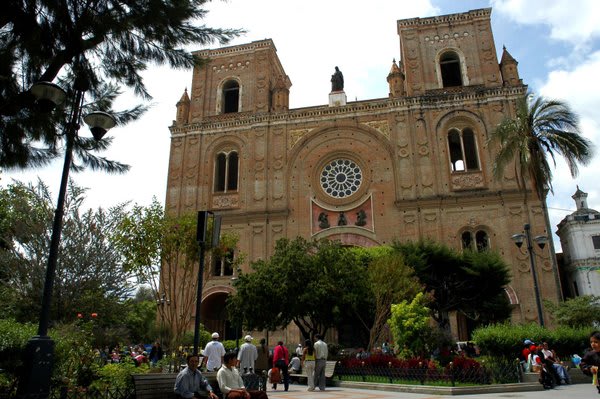
Departing Quito & Cruise Embarkation
AM: Upon arrival at Baltra airport, you will pass through an airport inspection point to ensure that no foreign plants or animals are introduced to the islands, as well as to pay the park entrance fee of USD 100 (unless it has been prepaid). A guide will meet you, help you collect your luggage, and escort you on a short bus ride to the harbour. Here you will climb aboard the yacht Solaris. After greeting the crew and the captain, your cabins will be assigned to you and then you will enjoy your first lunch aboard.
PM: These two small beaches are found to the west of Turtle Cove. Their sand is made of decomposed coral, which makes it white and soft, making it a favourite nesting site for sea turtles. There is a small brackish water lagoon behind one of the beaches, where occasionally it is possible to observe flamingos and other coastal birds, such as black-necked stilts and whimbrels. The other beach is longer, but it has two old barges that were abandoned during the Second World War when the USA used Baltra Island as a strategic point to protect the Panama Channel.
Meals: (B, L, D)

Tintoreras, Wetlands, Wall of Tears & Tortoise Breeding Centre
AM: Tintoreras consists of several small islets off the coast of Puerto Villamil and is one of the most emblematic visitor’s sites of the Galapagos. Its impressive concentration of Galapagos wildlife can be admired easily during the tour From a viewpoint, you can see herons on mangrove branches whilst Galapagos penguins and sea lions can be spotted on the land. Whitetip reef sharks can be found in the tidal channels, and their abundance is what gives these islets their Spanish name. Another highlight is the breeding colony with uncountable numbers of marine iguanas!
PM: After lunch aboard, you will visit the local tortoise breeding centre, where you can see hundreds of giant Galapagos tortoises of all sizes. The vulnerable hatchlings are not gigantic at all, even smaller than the size of your hand! This project, just outside Puerto Villamil, was created to rescue the endangered populations of Isabela’s southernmost volcanoes. In Puerto Villamil and the surrounding wetlands, there is the historical site called “The Wall of tears”, a national cultural heritage place where punished prisoners were forced to build this long wall and useless wall of lava rocks. Also, you might have the chance to see American flamingos. At the end of the afternoon, you will have some free time to explore the village and/or its beach.
Meals: (B, L, D)

Moreno Point, Punta Mangle & Tagus Cove
AM: Moreno Point is located on the north coast of Isabela Island, between the volcanos Sierra Negra and Cerro Azul. The trail runs along a solidified pahoehoe lava flow into a complex of coastal lagoons. Its main attractions are several species of birds, which are found around the lakes and mangrove forests.
PM: You will enter the Bolivar Channel and navigate towards Tagus Cove. On the way, you will see how explosive eruptions have blown out a part of the outer rims of both tuff cones, and created their characteristic horseshoe shapes and Tagus Cove. Sailors used to write the names of their vessels on the eastern cliffs of this place. A tour along the cliffs in a dinghy will give the visitors a good chance to see the Galapagos penguin, the flightless cormorant and other sea birds. From the landing dock, it is about a 30-minute hike along the trail up to the top of the cliff from where you can view Darwin Lake; an uplifted ultra saline lake saltier than the sea. You can also see several volcanoes from this location. Look carefully at the graffiti on the surrounding cliffs of the cove! They were written by pirates, whalers and buccaneers in past centuries.
Meals: (B, L, D)
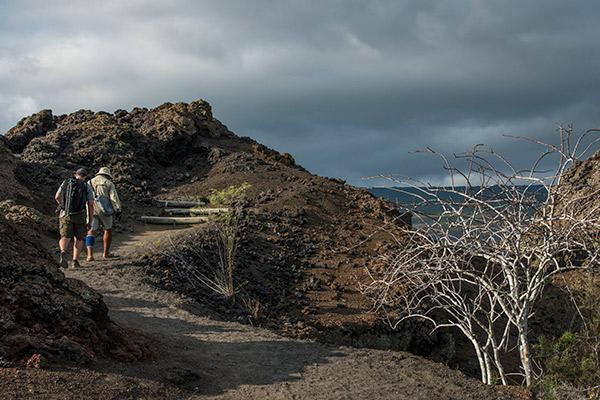
Punta Espinoza & Vicente Roca Point
AM: Fernandina is the third-largest island in the archipelago and has a single visitor site: Punta Espinoza, located at the northeastern tip of the island. Marine iguanas conglomerate in larger groups than on any other island. They bask around in the sand, swim near the shore and sometimes block the way at the landing dock. Among the unique species found here, is the flightless cormorant. This bird had to adjust its way of survival and perfect its skills of finding food in the ocean. Their wings, tails and feet progressively adapted for swimming. To see these birds is to witness evolution happening right in front of you.
PM: Whilst having lunch, the yacht will cross the Bolivar Channel for the last time to Vicente Roca Point, just at the mouth of Isabela’s seahorse shape. While entering a dark cave below a spectacular arch, the roaring echoes of the waves will accompany you. Just around the corner, the collapsed amphitheatre of Ecuador Volcano offers another impressive view. The calmer waters of the coves are well protected against the ocean swell and are a fairly cold but great place for snorkelling amongst various species of shark, penguins, pufferfish and even seahorses!
Meals: (B, L, D)
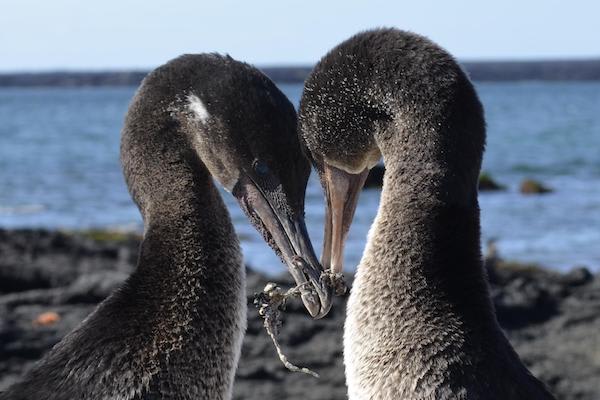
Espumilla Beach, Bucaneer Cove & Puerto Egas
AM: Espumilla Beach is a visitor’s site at the northern end of James Bay, on the western coast of Santiago. This beach has been revived as an important breeding site for turtles, as it is no longer suffering from digging wild pigs. The turtles return year after year to bury their eggs into the cinnamon-coloured sand dunes. The beach ridge hides mangroves with two picturesque lagoons. The colony of American flamingos and aquatic birds used to be its main attraction, but after the climate phenomenon of El Niño, strong sedimentation altered the brackish water environment and it no longer contains their food. During the climb of a hill, you will be rewarded with a beautiful overview of the transitions from sea into beach into mangrove into dry palo santo forest.
PM: At lunchtime, you will navigate south to Puerto Egas, with its famous fur seal grottos, where you will enjoy another, very different guided walk along the coastline. Its masterfully sculptured coastline of black basalts and polished multi-coloured ash layers forms a photogenic scene with collapsed lava tunnels, natural arches, caves and blowholes such as “Darwin’s toilet”. In a grotto directly below a spectacular rock arch at the end of the beach, a colony of sea lions occupies the shade. Hundreds of sally lightfoot crabs seem even brighter orange against the black rocks.
Meals: (B, L, D)

Rabida & Chinese Hat
AM: After lunch and a “wet landing” on the remarkable red beach of Rabida, there are two short guided hikes. Oxidised iron particles give the rocks and sand their rusty colour. The beach wall holds a shallow green-fringed lagoon. This oasis is the most fertile place on the otherwise arid islet, which is overgrown with leaf-dropping palo santo trees. The salty pool attracts all kinds of aquatic birds, like pintails and sometimes American flamingos. Between the evergreen foliage of the surrounding mangrove bushes, many species of songbirds hide and breed. One of the most outstanding attractions is the major breeding colony of brown pelicans; the only ones in the world that plunge-dive.
PM: Chinese Hat is a 52 m/170 ft high volcanic cone, forming an islet off the rocky coast of Santiago, where a small colony of Galapagos penguins has settled. Because its primordial fire has been extinguished recently, this is an excellent place to learn more about volcanism, lava bombs and lava tunnels. On the beach, you can also find curious pillow-type lavas with coral heads on top! These spheres had a submarine origin before being lifted above sea level. Beaches of white coral sand grow, and holes in the eroding lava fields are filled up with lava sand, which enables rooting. Galapagos sea lions and countless marine iguanas contribute to fertilisation. This all together creates more favourable options for newcomers, like saltbush and the discolouring sesuvium carpet.
Meals: (B, L, D)

Disembarkation
AM: The dinghies will bring you to the touristic pier of Puerto Ayora, from where you will be brought to the Charles Darwin Research Station and the headquarters of the Galapagos National Park Service, from which biological research and indispensable conservation management of this unique but vulnerable archipelago are directed. You will be taken on an educational stroll where your most memorable visit will be that of the successful breeding centre and the enclosure of the Galapagos giant tortoises.
After that, it is time to say goodbye to the Galapagos! It has been a pleasure accompanying you on this unique trip and we hope to see you again very soon. Assisted by the naturalist guide and some crew members, the dinghy will bring you and your luggage to the pier, where you will take the shuttle back to the airport. In case you have booked your trip for a longer stay with us, we would be welcoming any potential new fellow passengers to the yacht, and continue our trip to the next visiting site!
Meals: (B)

Accommodations
Cruises & Lodges

Solaris Yacht
Hotel Options
Patio Andaluz
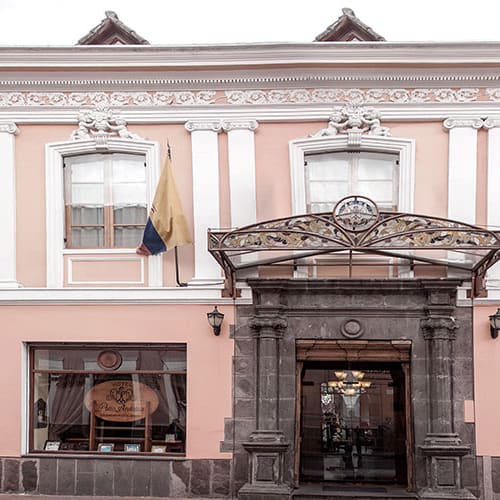
Hacienda El Porvenir

Hacienda Abraspungo

Santa Lucia

Wyndham Quito
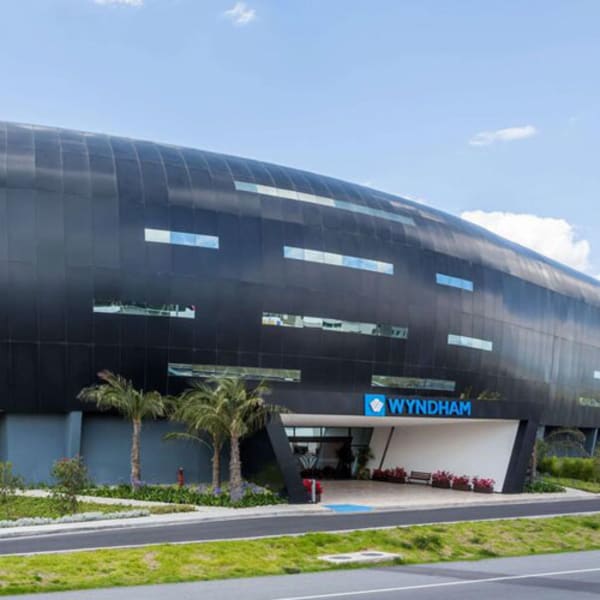
Related Tours

- Galapagos
- Machu Picchu
- Ecuador
- Peru
Machu Picchu & Galapagos
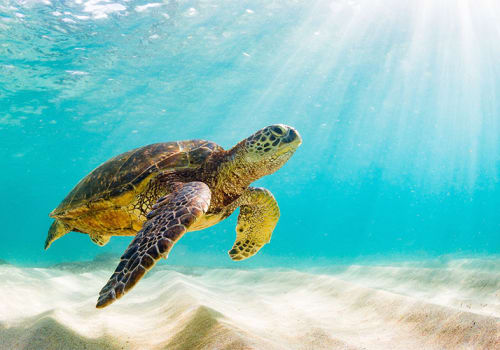
- Galapagos
- Machu Picchu
- Chile
- Ecuador
- Peru
Galapagos, Easter Island & Machu Picchu

- Peru
- Ecuador
- Galapagos
Inca Trail & Galapagos
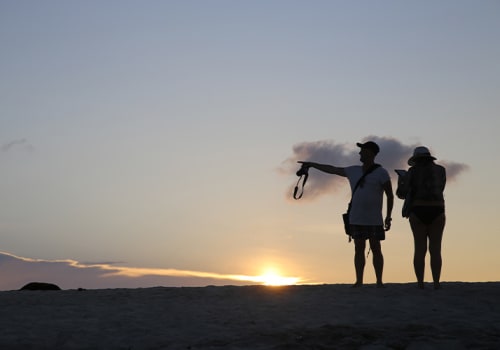
- Galapagos
- Ecuador
Best Of Ecuador & Galapagos
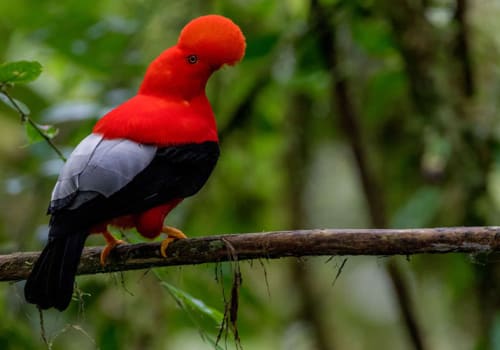
- Amazon
- Ecuador
Ecuador Cloud Forest & Amazon

- Galapagos
- Ecuador
Galapagos In Style
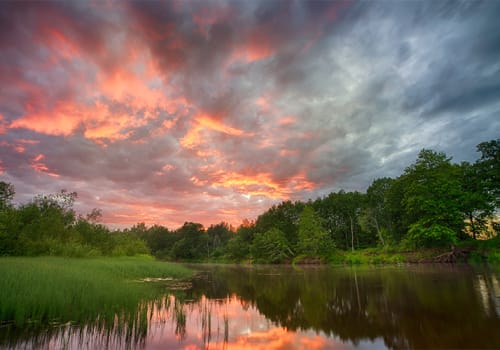
- Amazon
- Galapagos
- Ecuador
Galapagos & Amazon
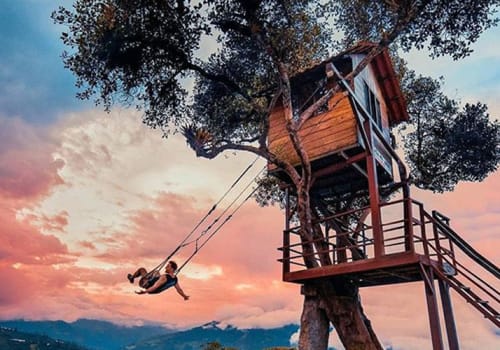
- Galapagos
- Ecuador
Galapagos & Andes
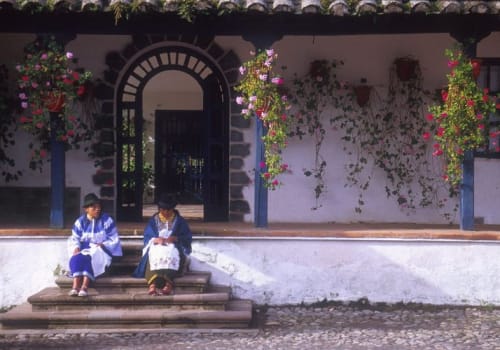
- Amazon
- Ecuador
Quito To Amazon
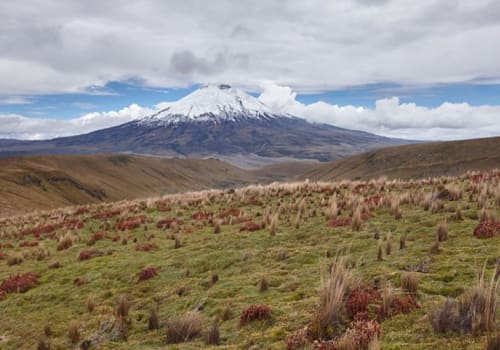
- Amazon
- Galapagos
- Ecuador
Galapagos & Cotopaxi Expedition
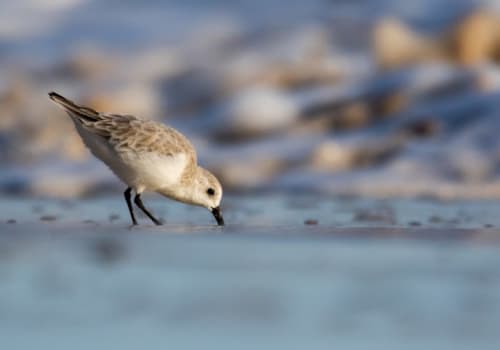
- Galapagos
- Ecuador
Galapagos Camping Adventure
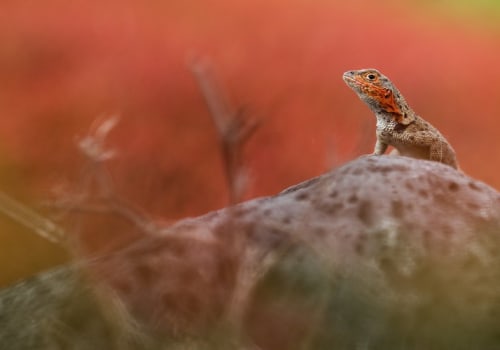
- Galapagos
- Ecuador
Galapagos Islands Land Based
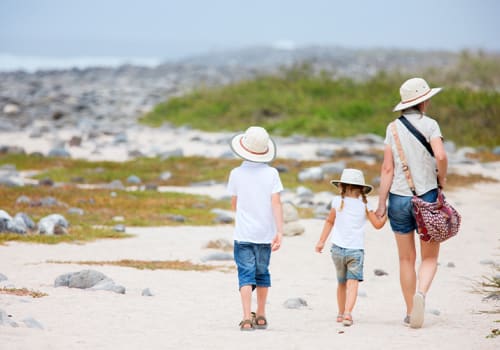
- Galapagos
- Ecuador

